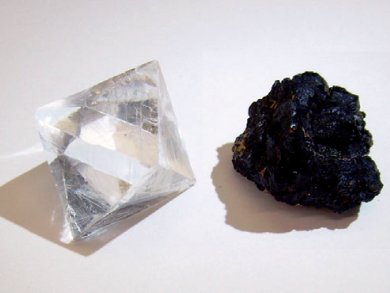Elemental Fluorine
Why does “fetid fluorite”, a mineral that is found in the Upper Palatinate in Bavaria, Germany, have such an unpleasant sharp smell when it is crushed? Scientists in Munich have now found the solution to this puzzle, not only bringing an end to a controversial discussion that has been going on for about 200 years, but also altering a hard and fast textbook rule. In the journal Angewandte Chemie, the researchers have demonstrated that the stench is caused by elemental fluorine. This unambiguously proves that despite prior assumptions, elemental fluorine does occur in nature.
Elemental fluorine (F2) is an extremely reactive gas that attacks nearly all materials; it even eats away at laboratory glassware. In contrast, chemically bound fluorine atoms in inorganic or organic compounds are – in proper doses – harmless and actually quite useful, whether in fluoride toothpaste, flame retardant materials, or Teflon. It is no wonder that chemists have so far been convinced that fluorine cannot occur in nature in its elemental form, but only as the fluoride ion, for example in minerals like fluorite (CaF2, pictured, left).
“Fetid Fluorite”
One special form of fluorite is found in the “Maria” mine in Wölsendorf in the Upper Palatinate in Germany. The unusual thing about this mineral is its odor, which pricks the nose as soon as this “fetid fluorite” or “antozonite” (pictured, right) is crushed. But what causes the smell? Experts have been arguing about this for almost 200 years. A number of important chemists, including Friedrich Wöhler (1800–1882) and Justus von Liebig (1803–1873), discussed possible different substances that may be responsible for the smell. Over the years, elemental fluorine; iodine; ozone; compounds of phosphorus, arsenic, sulfur, and selenium; chlorine; hypochloric acid; and fluoridated hydrocarbons have all been blamed for the stench.
Florian Kraus of the TU Munich, as well as Jörn Schmedt auf der Günne and Martin Mangstl at the Ludwig Maximilians University in Munich have now obtained direct proof: Elemental fluorine is the guilty party that causes the unpleasant odor. By using 19F nuclear magnetic resonance spectroscopy (NMR spectroscopy), they were able to show for the first time that elemental fluorine is contained in “antozonite”.
How is this possible for such a reactive gas? The researchers explain that “antozonite” contains a tiny amount of uranium that, together with its radioactive daughter nuclides, constantly releases radiation into the surrounding mineral. This causes fluorite to split into calcium and elemental fluorine, forming the calcium clusters that give “antozonite” its dark purple color. The fluorine is contained in tiny enclaves surrounded by nonreactive fluorite, which shields it from the calcium, allowing it to maintain its elemental form.
- Occurrence of Difluorine F2 in Nature—In Situ Proof and Quantification by NMR Spectroscopy,
Jörn Schmedt auf der Günne, Martin Mangstl, Florian Kraus,
Angew. Chem. Int. Ed. 2012.
DOI: 10.1002/anie.201203515




